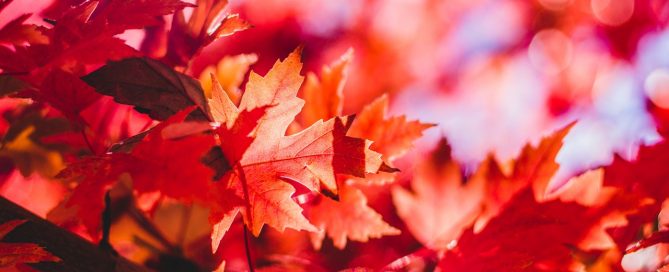Get Your Heart Pumping with Some Fiery Fall Foliage
When the weather gets cool, some really like it hot…fiery red hot, that is. The heat we’re talking about is blazing red foliage — bursts of color that some find ease the pain of the outdoor season coming to an end.
In fact, experts say the color red goes beyond sensual pleasure. It stimulates the human system — even increasing pulse and heart rates.
However, brilliant red foliage outside our very own windows requires planning. To get all the dirt on what trees to plant, we spoke with Angelo Puleo, Nursery Division at Bissett Nursery (Holtsville, NY).
“One of the most popular and widespread deciduous trees that produces bright reds in autumn is the beautiful Maple tree,” says Pueleo. “In particular, we recommend Sugar Maples, and, of course Oaks for great fall red color.”
Note: Be sure to ask experts at an established nursery or landscaping firm which variety of maple, etc. will produce red leaves in fall, as some varieties offer up a blazing yellow instead. Not that there’s anything wrong with that…it’s just for another blog post.
Puleo also recommends the Cleveland Select Pear for robust color. Like the Oak and Maple, it is also hardy and can withstand most winds and storms, including ice storms — a real plus in our neck of the woods (the Northeast).
“In spring, the Cleveland Select bursts awake in beautiful white flowers, and in the fall, its leaves offer up a deep orangey-red blaze of color,” he says.
When it comes to smaller trees, Deck and Patio designers often consider Japanese Maples in landscaping plans; red-leafed versions of this beautiful tree offer degrees of red from spring through fall (see last photo). Planting them in early fall allows for new root growth in time for spring.
Another option is the Crape Myrtle tree (immediately below), which, as Puleo admits, is not quite as brilliant as the other trees, but it does offer an attractive reddish-orange color.
In addition, when the Crape Myrtle finishes flowering in fall, it pods-up with berries, and attracts such delightful visitors as the Yellow-rumped Warbler, a sweet little visitor who feeds on these berries after insects are gone.
The Crape Myrtle tree that thrives on Long Island is a hybrid of other Crape Myrtles that flourish in warmer climates such as the Southern United States. Clusters of pink blossoms appear in late spring (shown here) which are so delicate and crinkly they look like they are made of crape paper. In fall, it showcases bright red-orange-y leaves.
This beautiful Japanese Maple is native to Japan and other nearby Asian countries such as South Korea. It’s prized for the shape of its leaves and rich red color.
So, get your heart pumping every time you walk outdoors come fall. The fiery red scene will so take you away that you’ll forget you’re wearing a jacket.




















